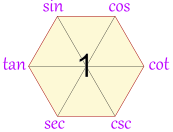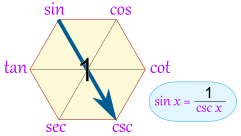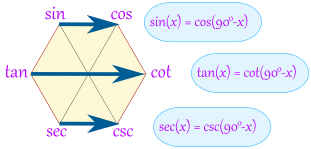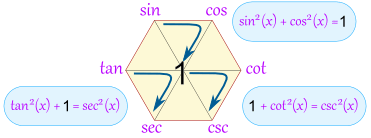این یادداشت رو سر فرصت تکمیل می کنم . . .
روش دایره مثلثاتی
روش شش ضلعی جادویی برای اتحادهای ساده
درباره عدد i و جواب کلی معادله درجه دوم
روش فرمول اویلر برای جمع زوایا و ...
روش ترکیبی فرمول اویلر و فرمول دوموار برای اتحادهای پیشرفته تر
این یادداشت رو سر فرصت تکمیل می کنم . . .
روش دایره مثلثاتی
روش شش ضلعی جادویی برای اتحادهای ساده
درباره عدد i و جواب کلی معادله درجه دوم
روش فرمول اویلر برای جمع زوایا و ...
روش ترکیبی فرمول اویلر و فرمول دوموار برای اتحادهای پیشرفته تر
| This hexagon is a special diagram to help you remember some Trigonometric Identities |  |
Sketch the diagram when you are struggling with trig identities ... it may help you! Here is how:
Start with: tan(x) = sin(x) / cos(x)
|  | ||
Then add:
|  | ||
| To help you remember: the "co" functions are all on the right | |||
OK, we have now built our hexagon, what do we get out of it?
Well, we can now follow "around the clock" (either direction) to get all the "Quotient Identities":
| Clockwise |
|
| Counterclockwise |
|
The hexagon also shows that a function between any two functions is equal to them multiplied together (if they are opposite each other, then the "1" is between them):
 | |
| Example: tan(x)cos(x) = sin(x) | Example: tan(x)cot(x) = 1 |
Some more examples:
You can also get the "Reciprocal Identities", by going "through the 1"
 | Here you can see that sin(x) = 1 / csc(x) |
Here is the full set:
AND we also get these:

Examples:
The Unit Circle shows us that
sin2 x + cos2 x = 1
The magic hexagon can help us remember that, too, by going clockwise around any of these three triangles:

And we have:
You can also travel counterclockwise around a triangle, for example: